    |
Tourism and Hiking around La Bastide
|
   
|

 We arrive
in the afternoon, some by car and others by the train "le Cévenol". The weather is nice and the reunions are always so friendly. We settle in at the guesthouse "L'Etoile", a former holiday hotel from the 30s on the banks of the Allier, the river that separates Ardèche and Lozère. Our organizers take us on a walk through the village of La Bastide-Puylaurent and to the Béal pond
which is set up for trout farming. Their production is also sold caught by nets. Our hunter-fisherman Popeil gives us a demonstration on how to bait the trout
by throwing red fruits found on site, and it works...
We arrive
in the afternoon, some by car and others by the train "le Cévenol". The weather is nice and the reunions are always so friendly. We settle in at the guesthouse "L'Etoile", a former holiday hotel from the 30s on the banks of the Allier, the river that separates Ardèche and Lozère. Our organizers take us on a walk through the village of La Bastide-Puylaurent and to the Béal pond
which is set up for trout farming. Their production is also sold caught by nets. Our hunter-fisherman Popeil gives us a demonstration on how to bait the trout
by throwing red fruits found on site, and it works...
 15.5 km loop hike
15.5 km loop hike
Departure towards the Abbey of "Notre Dame des Neiges" in the municipality of St Laurent les Bains in Ardèche following the GR®72 (shared with the GR®7). Founded by the Cistercian Trappists in 1864. Visit of the cellars, meditation, but
also tasting of a dry white and a sweet white. A tourist hotspot for visitors from Nîmes and Alès.
From his stay at Notre-Dame des Neiges, Robert Louis Stevenson writes: "At this late season, the residents were few. Yet I was not alone in the
public part of the monastery. It is located near the entrance door and includes a small dining room on the ground floor and, upstairs, an entire corridor of cells similar to mine." Our immersion in meditation will take place during a little stroll on the ridges of the GR®7 in search of a picnic spot with a stunning view
of the Valley of the Borne. Return to La Bastide-Puylaurent via the Valley of Serres and Rogleton where we rediscover the old route of Stevenson that runs along the Allier.
Tourism on the water divide
We head towards the small village of Puylaurent which is now just a hamlet of the municipality of La Bastide-Puylaurent but where there is a
small chapel of great beauty, as well as a stunning view of the Goulet and Mont Lozère. On the way, we stop at the dolmen of Thort. It is the "Palet de Gargantua" (Has he followed us from Brittany to Lozère? Or did he stay in armor and throw his disc until here?) The dolmen of Thort is located 200m from the hamlet in the direction of Prévénchères on the GR®72 and GR®700.
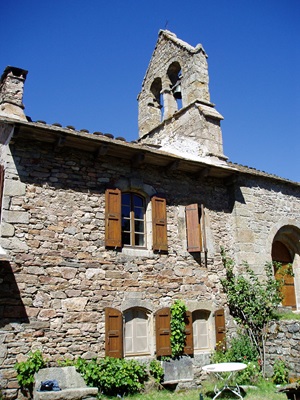 Visit to the Puylaurent dam
built on the Chassezac river. The Puylaurent dam is the largest dam built in France at the end of the 20th century. Its construction began in June 1990 and was completed in May
1996 with its water reservoir. The project mobilized 15 companies under the management of the departmental equipment union of Ardèche and the technical direction of EDF Hydraulic Engineering. 200 people for 500,000 hours of work.
Visit to the Puylaurent dam
built on the Chassezac river. The Puylaurent dam is the largest dam built in France at the end of the 20th century. Its construction began in June 1990 and was completed in May
1996 with its water reservoir. The project mobilized 15 companies under the management of the departmental equipment union of Ardèche and the technical direction of EDF Hydraulic Engineering. 200 people for 500,000 hours of work.
We cross Prévénchères, without giving a glance at the famous chocolate shop
that has since moved to Les Vans. A detour is planned to the viewpoint of the Chassezac gorges just next to the small village of Albespeyres. The view is indeed breathtaking over the canyon, Pied de Borne and further away the Alps.
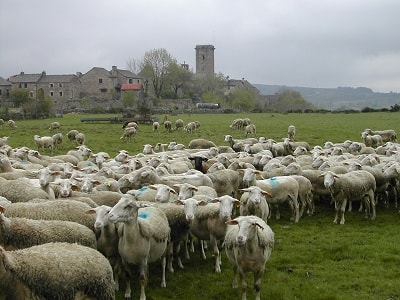 Then we head towards the medieval village of La Garde Guérin. A visit to the fortified village and the tower is planned. The passage
is difficult to the top but the view of Mont Lozère and the Chassezac canyon is very beautiful. In the village, a meeting between two experts in the Occitan language and a local elder. This old villager was happy to chat in Patois. The Auberge de La Régordane, in the center of the village, will not be able to accommodate us, it's all booked!
Then we head towards the medieval village of La Garde Guérin. A visit to the fortified village and the tower is planned. The passage
is difficult to the top but the view of Mont Lozère and the Chassezac canyon is very beautiful. In the village, a meeting between two experts in the Occitan language and a local elder. This old villager was happy to chat in Patois. The Auberge de La Régordane, in the center of the village, will not be able to accommodate us, it's all booked!
We will go to Villefort following the Via St Gilles or the Régordane path. Route of the Arvernians and Greeks. The one for the knights, pilgrims, and peddlers. For jugglers and troubadours. Route of wine, spices, pure salt as well as oil and cheese. But also a strategic route for tin to the Mediterranean. From the Frankish knighthood marching against the Saracens. Still no nap.
We leave by the D.901 towards Altier, we pass by the upper town and the lower town. We stop at the village of Bleymard to admire its small chapel and then crossing Bagnols les Bains, we head towards Mende. A very quick visit of the city, its cathedral and its old houses and narrow streets.
Then via the N. 106 we reach Rieutort
de Randon and Châteauneuf de Randon. A town that has a statue of Dugesclin and became one of the strongholds of Gévaudan, which fell, in 1361, into the hands of the great companies, one of whose leaders, Séguin de Badifol, a Gascon knight, ran the country at the head of 3000 plunderers. Twenty years later, in 1380, others took it. These companies, half English and half Gascon, taking advantage of the wars between France and England, had settled in several strongholds in Auvergne and Languedoc. "O honor
and chivalry, you will lose everything when this one defines!"
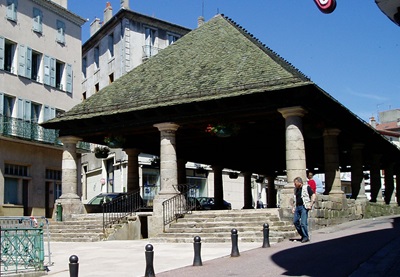 Departure for Langogne, we admire the Grain Hall built by the Fleury priory in 1742. Fourteen stone pillars support the wooden framework and slate roof of the Tournel.
Under this cover was the grain market and the priory retained a measuring fee for the measuring of these grains. We quickly visit the Romanesque church with its Gothic facade from the 15th century.
Departure for Langogne, we admire the Grain Hall built by the Fleury priory in 1742. Fourteen stone pillars support the wooden framework and slate roof of the Tournel.
Under this cover was the grain market and the priory retained a measuring fee for the measuring of these grains. We quickly visit the Romanesque church with its Gothic facade from the 15th century.
Langogne worships "Notre Dame de tout pouvoir" (and not the black virgin). Visit to the Calquières spinning mill. Various machines, dating from the beginning of the industrial era,
allowed from raw wool to obtain narrow bands, then threads thanks to a huge machine replacing a hundred spinners and their
distaff.
 Then return to La Bastide-Puylaurent via Cheylard l'Evêque. At Philippe's at L'Etoile, we feel at ease, discussing everything freely and openly, enjoying the scenery and calm, sitting under the large lime tree in the park alongside the
river, and as the time of departure arrives, we promise to return to renew this first successful experience.
Then return to La Bastide-Puylaurent via Cheylard l'Evêque. At Philippe's at L'Etoile, we feel at ease, discussing everything freely and openly, enjoying the scenery and calm, sitting under the large lime tree in the park alongside the
river, and as the time of departure arrives, we promise to return to renew this first successful experience.
A big guy who also works hard on his websites to
promote his concept and share his motivation for another way of living together, working and developing this adventure he follows like a gold seeker. "I may be
a businessman but certainly not a merchant; money will come if the idea is good and rich"...
Thermal treatment at Saint Laurent les Bains in Ardèche
To whet the appetite, a small circuit around and above the village of St Laurent. Visit to the old signaling tower used in the medieval period to stay in contact with the other villages
like La Garde Guérin or Loubaresse.
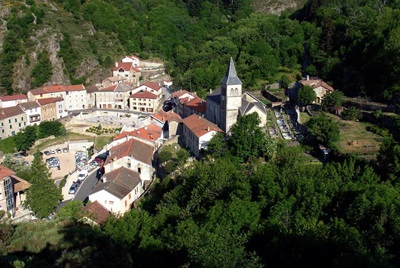 Descent to the village and setting up at the restaurant
to regain strength for our afternoon treatment. The patients are in attire, briefs, bathrobe, cap, towel, slippers, and on the way for 10 minutes in the vaporarium, in a
thick fog and a stifling temperature, they will all endure. They do not know what awaits them around the corners of the corridors. The next step is a bath
but in what liquid (just liquid). A bit of spring water, I suppose, mixed with a lot of kaolin (natural mix). Imagine a pool filled with milk with a lot of thick cream
added, of enormous density, making it impossible to stand, in total weightlessness. Additionally, this liquid was very sticky; despite a shower and a lot of elbow grease, I kept white marks
for three days. The last step is more pleasant. Swimming pool with spring water. Personal space with adjustable water jet allowing a massage from feet to head and
by turning in front or behind. During this healing stay, if our bodies suffered, I can tell you that our spirits were rejoicing. This experience was not sad.
Descent to the village and setting up at the restaurant
to regain strength for our afternoon treatment. The patients are in attire, briefs, bathrobe, cap, towel, slippers, and on the way for 10 minutes in the vaporarium, in a
thick fog and a stifling temperature, they will all endure. They do not know what awaits them around the corners of the corridors. The next step is a bath
but in what liquid (just liquid). A bit of spring water, I suppose, mixed with a lot of kaolin (natural mix). Imagine a pool filled with milk with a lot of thick cream
added, of enormous density, making it impossible to stand, in total weightlessness. Additionally, this liquid was very sticky; despite a shower and a lot of elbow grease, I kept white marks
for three days. The last step is more pleasant. Swimming pool with spring water. Personal space with adjustable water jet allowing a massage from feet to head and
by turning in front or behind. During this healing stay, if our bodies suffered, I can tell you that our spirits were rejoicing. This experience was not sad.
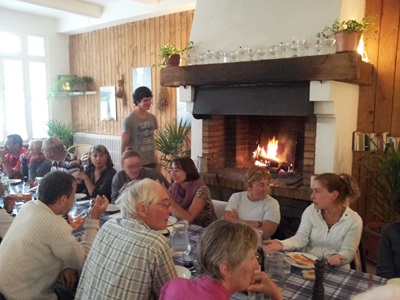 Around the large host table of L'Etoile, our group decided on an exploration of Haute-Ardèche for our first day. In the morning, we leave La
Bastide-Puylaurent for Luc and Langogne, following the Allier and then Pradelles in
Haute-Loire. We stop at the Issarlès lake and head back towards Bége.
Around the large host table of L'Etoile, our group decided on an exploration of Haute-Ardèche for our first day. In the morning, we leave La
Bastide-Puylaurent for Luc and Langogne, following the Allier and then Pradelles in
Haute-Loire. We stop at the Issarlès lake and head back towards Bége.
After crossing the Bonnefoy forest, we arrive at the foot of the Gerbier de Jonc and beside the
sources of the Loire. It is on the west side of this dome, a conical lava with an altitude of 1551 meters, where the sources of the Loire are located. We don't have time to admire the
scenery, the group is already on the way to the summit; the view from the top is stunning. Just as I catch my breath, the whole group is already coming back down. At the bottom,
some buy jams, others honey, and the rest approach the monument of the springs, attracted by an advertisement for Sancerre wines irrigated by the Loire.
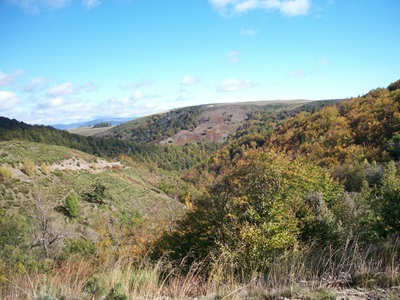 After a
picnic attempt at the pass of Mézenc, we give up. The spot is too windy for our paper plates and plastic cups. We descend to the sheltered slope and much lower down,
our friend Bitas finds us a clearing surrounded by conifers. A ritual unpacking is done by all, the material: tables, chairs, and provisions are brought to the work site, without
forgetting the little pear.
After a
picnic attempt at the pass of Mézenc, we give up. The spot is too windy for our paper plates and plastic cups. We descend to the sheltered slope and much lower down,
our friend Bitas finds us a clearing surrounded by conifers. A ritual unpacking is done by all, the material: tables, chairs, and provisions are brought to the work site, without
forgetting the little pear.
The afternoon is dedicated to Le Mézenc 1753 m. We climb to the peaks (there are two). With the orientation tables we were not lost, the horizon was still a bit cloudy. Some, in the clouds, swore they had glimpsed Mont Blanc. However, the Dune du Pilat was not visible. But Mont Pilat 1432 m, located between the Rhône Valley and the Loire Valley, could have been.
We head back to the lodge, stopping at the Recoumène viaduct. This masterpiece was built during the heroic era of the early railway by the engineer Séjourné. No trace of track remains, no more trains, perhaps out of respect for this work they preserved the bridge (I personally think it's more for economic reasons). It has been reclaimed by a bungee jumping association and has thus become somewhat touristy.
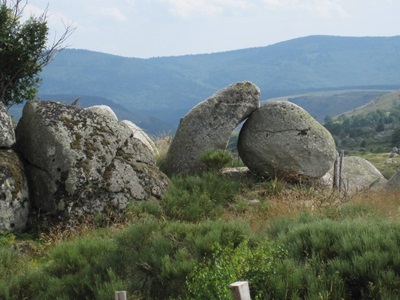 The peaks of Lozère
The peaks of Lozère
We set off taking the D.6 towards Masméjean. We cross Chasseradès, Mirandol, l'Estampe, the Goulet mountain, and we arrive at the small village of Bleymard. The food supply is done diligently, while some will visit this village located at the foot of Mont Lozère. Bleymard had 434 inhabitants. The village is at a crossroads of two roads; on one hand, the road from Mende to Villefort along the Lot and the Altier; on the other, the D. 20 coming from Belvezet, climbing and descending the slope of Goulet and barely crossing the village, attacking Mont-Lozère, towards Finiels and the Pont de Montvert. Via this D. 20, we ascend to the Bleymard ski station where three hotels are located.
 It's snack time, and during our meal, we have a stunning view of the valley and the mountains of the Cévennes. Without a nap and without rest, the group heads towards the col de Finiels. On this route, the trail is lined with standing stones, like menhirs.
It's snack time, and during our meal, we have a stunning view of the valley and the mountains of the Cévennes. Without a nap and without rest, the group heads towards the col de Finiels. On this route, the trail is lined with standing stones, like menhirs.
In foggy weather, these stones served as markers for shepherds when they were coming down from the mountain in autumn with their flocks. Only a portion of our group will reach the summit of Finiels 1699 m, due to several dropouts along the way. It's time for our efforts to stop. The bold shapes of the chapel of Mont Lozère built in 1967 by the Scouts of France surprised us. This roof shape aims to let snow slide to the ground, without the risk of accidents.
In these regions, the evolution of vegetation largely reflects the history of pastoralism and, conversely, the presence of forests. Thus, the beech and fir forests that populated Mt Lozère during the Gallo-Roman era were progressively destroyed by the herds. However, since the early 20th century, heath, pines, and birches have started to reclaim the abandoned pastures. The ONF also encourages the establishment of beeches and firs. Wild boars, deer, and roe deer have colonized these forests.
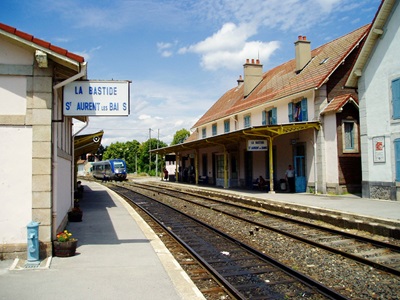 La Bastide-Puylaurent (province of Gévaudan).
La Bastide-Puylaurent (province of Gévaudan).
In the 18th century, La Bastide Puylaurent was just a hamlet of a few houses that lined the Régordane Way (it is the term by which it is referred to in ancient documents; the improper name of Voie Régordane - to sound Roman - only appears in the 20th century). It gets its name from the country of Régordane that it crosses, just as the Chemin de Forez takes its name from the surrounding mountains. This area, and even this province provincia de Regordana in 1323 in a deed from the Portes castle, would correspond approximately to the territory that extends between the towns of Alès, Chamborigaud, Génolhac, Villefort, La Garde-Guérin, Prévenchères, La Bastide, Luc, Langogne, Pradelles, and Largentières. There were a few inns, a bustling mule relay in the 17th and 18th centuries, where travelers and pilgrims found refuge and where, during heavy snowfalls, they would sometimes get stuck for several weeks. It wasn't until 1741 that a first church was built on the site where, a century later, the current building was erected.
 Here the railway line coming from Mende, Allenc, Belvezet, Chasseradès rejoins that of Paris to Marseille via Clermont-Ferrand, Nîmes with the "Cévenol." Unfortunately for it, the Nîmes-Clermont-Ferrand line hardly benefits from the promotional kindness of the SNCF like the TGV. Yet it allows the inhabitants of Nîmes and Montpellier, fans of peaceful hiking, to make round trips in a day to magnificent hikes up to more than 1,000 m in altitude.
Here the railway line coming from Mende, Allenc, Belvezet, Chasseradès rejoins that of Paris to Marseille via Clermont-Ferrand, Nîmes with the "Cévenol." Unfortunately for it, the Nîmes-Clermont-Ferrand line hardly benefits from the promotional kindness of the SNCF like the TGV. Yet it allows the inhabitants of Nîmes and Montpellier, fans of peaceful hiking, to make round trips in a day to magnificent hikes up to more than 1,000 m in altitude.
La Bastide-Puylaurent (La Bastide St-Laurent-les-Bains), at 1024 meters altitude, is at a sewing distance from the triple watershed of the Loire, Rhône, and Garonne basins, in the person of the Allier, Chassezac, and Lot, which arise on the neighboring high plateaus. At more than a thousand meters altitude, it's a great holiday spot for the summer away from the heat.
 The Trappist Abbey of Notre Dame des Neiges, a few kilometers to the east, attracts many visitors, some coming for the peace of this Cistercian cloister, others for the enchanting setting of this peaceful valley. The Trappists have proven to be excellent winemakers, and many came to procure quality wines harvested in the plains of Gard and Ardèche. It was at Notre Dame des Neiges that Charles de Foucauld, hermit of Tamanrasset, stayed, who entered the abbey as a novice in 1890 before leaving for the Sahara.
The Trappist Abbey of Notre Dame des Neiges, a few kilometers to the east, attracts many visitors, some coming for the peace of this Cistercian cloister, others for the enchanting setting of this peaceful valley. The Trappists have proven to be excellent winemakers, and many came to procure quality wines harvested in the plains of Gard and Ardèche. It was at Notre Dame des Neiges that Charles de Foucauld, hermit of Tamanrasset, stayed, who entered the abbey as a novice in 1890 before leaving for the Sahara.
Robert Louis Stevenson also stopped at the abbey.
"In a meticulous way, the day is divided among various tasks. The man who takes care of the rabbits, for example, rushes from his hutch to the chapel, to the chapter room, or to the refectory throughout the day. At all times, he has an office to sing, a task to fulfill. From two hours when he gets up in the dark, until eight o'clock when he returns to receive the comforting gift of sleep, he remains standing absorbed by multiple and changing jobs." Stevenson
 The thermal waters of St Laurent les Bains have been renowned for centuries. People have been coming to take the waters since the 18th century, despite the difficult paths (GR®72 linking Mont Lozère to Col du Bez passing through Villefort, Prévenchères, Le Thort, La Bastide-Puylaurent and the abbey Notre Dame des Neiges). The station benefitted for a time, in the 19th century, from the popularity of thermal waters. The construction of the railway from Paris to Nîmes and the proximity of the stations of La Bastide-Puylaurent and Langogne allowed it to welcome curists from the major cities in the south of France such as Marseille, Nîmes, Montpellier, Clermont-Ferrand, or Lyon. But in the 1960s, it had to close due to a lack of clients. In 1987, the thermal chain of the sun restored the entire station. At that time, it was believed that mainly skin diseases were treated due to the sulfur properties of these waters. The recent advertisements for this station only mention treatments for rheumatism and sciatica.
The thermal waters of St Laurent les Bains have been renowned for centuries. People have been coming to take the waters since the 18th century, despite the difficult paths (GR®72 linking Mont Lozère to Col du Bez passing through Villefort, Prévenchères, Le Thort, La Bastide-Puylaurent and the abbey Notre Dame des Neiges). The station benefitted for a time, in the 19th century, from the popularity of thermal waters. The construction of the railway from Paris to Nîmes and the proximity of the stations of La Bastide-Puylaurent and Langogne allowed it to welcome curists from the major cities in the south of France such as Marseille, Nîmes, Montpellier, Clermont-Ferrand, or Lyon. But in the 1960s, it had to close due to a lack of clients. In 1987, the thermal chain of the sun restored the entire station. At that time, it was believed that mainly skin diseases were treated due to the sulfur properties of these waters. The recent advertisements for this station only mention treatments for rheumatism and sciatica.
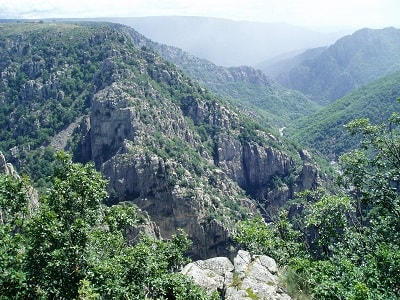 The Chassezac, born at Moure de la Gardille, flows into the Ardèche after a course of 80 km; it waters the meadows of Belvezet, passes under the important viaduct of Mirandol and quickly plunges 25 to 30 meters into a narrow slot between two granite walls. Then its bed widens and cascades down under the hamlet of Mas, south of Chasseradès. Between Puylaurent and L'Hermet, it narrows again and plunges 95 m deep. Then it flows peacefully for 5 or 6 km between green meadows, under ash trees and poplars. After flowing past the station of Prévenchères, it spreads into a superb lake, the lake of Rachas, where a dam holds it back.
The Chassezac, born at Moure de la Gardille, flows into the Ardèche after a course of 80 km; it waters the meadows of Belvezet, passes under the important viaduct of Mirandol and quickly plunges 25 to 30 meters into a narrow slot between two granite walls. Then its bed widens and cascades down under the hamlet of Mas, south of Chasseradès. Between Puylaurent and L'Hermet, it narrows again and plunges 95 m deep. Then it flows peacefully for 5 or 6 km between green meadows, under ash trees and poplars. After flowing past the station of Prévenchères, it spreads into a superb lake, the lake of Rachas, where a dam holds it back.
Then the untamed river plunges into its great canyon, impossible to follow after Albespeyres. But a belvedere of the Chassezac gorges is arranged at the edge of the old D.906 that connects Alès to Langogne. In good weather, the spectacle is truly grand: upstream, two waterfalls; then the waters circle around an immense heap of granite, seep into a narrow neck and plunge into the "devil's cauldron": the rock drops steeply on both sides for 300 m. Then it flows, forming a Z, on a fine track it has carved into the hard rock. It is there between two towers: that of La Garde Guérin and that of Roure.
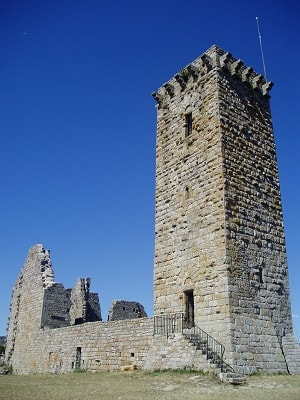 The medieval village of La Garde-Guérin
The medieval village of La Garde-Guérin
This beautiful watchtower, once surrounded by ramparts of which only ruins remain, raises its imposing mass. In the "Etymological Dictionary of Place Names in France," we can read that the word Garde comes from the Germanic Wart and means guard, watchtower, fortress. Castle and partly restored village form a beautiful medieval ensemble. It was the domain of the "Pariés," a very original association of knights and squires, a police militia that protected and guided travelers on the Régordane Way or St Gilles Path.
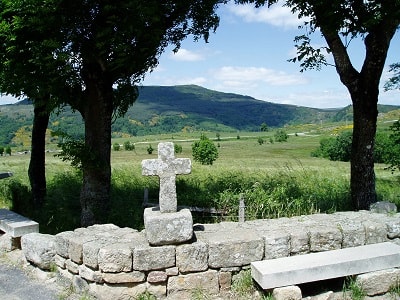 This path became, in the Middle Ages, after the division of the Carolingian Empire, which placed the Rhône Valley in the German Empire and made the Régordane Path the most eastern route of the Kingdom. About thirty lived on La Garde-Guérin, with detailed and precise statutes governing the distribution of income and succession of parétries. They depended on the Barons (the Guérins) of Tournel.
This path became, in the Middle Ages, after the division of the Carolingian Empire, which placed the Rhône Valley in the German Empire and made the Régordane Path the most eastern route of the Kingdom. About thirty lived on La Garde-Guérin, with detailed and precise statutes governing the distribution of income and succession of parétries. They depended on the Barons (the Guérins) of Tournel.
In a text written in the 12th century, in late Latin, one can read: "castrum quod vocatur la Garda," the fortress called La Garde. It is unclear exactly when the name of Guérin was added to La Garde. It is generally believed that the lords who settled in La Garde around the 12th century were Guérins, a surname common to the three baronies of Randon, Apcher, and Tournel. Bishop Aldebert III of Tournel made an expedition against them and besieged their lair; from gendarmes, they had become thieves and robbed those they were supposed to protect. They submitted and returned to the right path. Their brotherhood lasted until the French Revolution.
The railway lines at La Bastide-Puylaurent
The construction of the section Mende > La Bastide Puylaurent generates many problems. After deciding to dig a 2124 m tunnel under the Goulet mountain, construction stopped after a third of the route. The current route was chosen through Allenc, Belvezet, Chasseradès with a climb of 1215 m near Belvezet. To protect this route from snow, costly snow barriers had to be installed, then covered galleries; and it is far from being a fast track! The other line, that of the Cévennes, which connects Nîmes to Clermont-Ferrand via Alès and Langogne, is quite hilly and rises, between Alès and La Bastide-Puylaurent, 897 m over 66 km. It is one of the three steepest ramps in Europe.

Former resort hotel with a garden on the banks of the Allier, L'Étoile Guesthouse is located in La Bastide-Puylaurent, nestled between Lozère, Ardèche, and the Cevennes in the mountains of Southern France. Positioned at the crossroads of GR®7, GR®70 Chemin Stevenson, GR®72, GR®700 Voie Regordane (Saint Gilles), GR®470 Sources and Gorges of the Allier, GRP® Cevenol, Montagne Ardechoise, and Margeride. It offers numerous loop routes for hiking and day-long cycling excursions. Ideal for a relaxing stay.
Copyright©etoile.fr

 We arrive
in the afternoon, some by car and others by the train "le Cévenol". The weather is nice and the reunions are always so friendly. We settle in at the guesthouse "L'Etoile", a former holiday hotel from the 30s on the banks of the Allier, the river that separates Ardèche and Lozère. Our organizers take us on a walk through the village of La Bastide-Puylaurent and to the Béal pond
which is set up for trout farming. Their production is also sold caught by nets. Our hunter-fisherman Popeil gives us a demonstration on how to bait the trout
by throwing red fruits found on site, and it works...
We arrive
in the afternoon, some by car and others by the train "le Cévenol". The weather is nice and the reunions are always so friendly. We settle in at the guesthouse "L'Etoile", a former holiday hotel from the 30s on the banks of the Allier, the river that separates Ardèche and Lozère. Our organizers take us on a walk through the village of La Bastide-Puylaurent and to the Béal pond
which is set up for trout farming. Their production is also sold caught by nets. Our hunter-fisherman Popeil gives us a demonstration on how to bait the trout
by throwing red fruits found on site, and it works... 
 Visit to the Puylaurent dam
built on the Chassezac river. The Puylaurent dam is the largest dam built in France at the end of the 20th century. Its construction began in June 1990 and was completed in May
1996 with its water reservoir. The project mobilized 15 companies under the management of the departmental equipment union of Ardèche and the technical direction of EDF Hydraulic Engineering. 200 people for 500,000 hours of work.
Visit to the Puylaurent dam
built on the Chassezac river. The Puylaurent dam is the largest dam built in France at the end of the 20th century. Its construction began in June 1990 and was completed in May
1996 with its water reservoir. The project mobilized 15 companies under the management of the departmental equipment union of Ardèche and the technical direction of EDF Hydraulic Engineering. 200 people for 500,000 hours of work. Then we head towards the medieval village of La Garde Guérin. A visit to the fortified village and the tower is planned. The passage
is difficult to the top but the view of Mont Lozère and the Chassezac canyon is very beautiful. In the village, a meeting between two experts in the Occitan language and a local elder. This old villager was happy to chat in Patois. The Auberge de La Régordane, in the center of the village, will not be able to accommodate us, it's all booked!
Then we head towards the medieval village of La Garde Guérin. A visit to the fortified village and the tower is planned. The passage
is difficult to the top but the view of Mont Lozère and the Chassezac canyon is very beautiful. In the village, a meeting between two experts in the Occitan language and a local elder. This old villager was happy to chat in Patois. The Auberge de La Régordane, in the center of the village, will not be able to accommodate us, it's all booked! Departure for Langogne, we admire the Grain Hall built by the Fleury priory in 1742. Fourteen stone pillars support the wooden framework and slate roof of the Tournel.
Under this cover was the grain market and the priory retained a measuring fee for the measuring of these grains. We quickly visit the Romanesque church with its Gothic facade from the 15th century.
Departure for Langogne, we admire the Grain Hall built by the Fleury priory in 1742. Fourteen stone pillars support the wooden framework and slate roof of the Tournel.
Under this cover was the grain market and the priory retained a measuring fee for the measuring of these grains. We quickly visit the Romanesque church with its Gothic facade from the 15th century. Then return to La Bastide-Puylaurent via Cheylard l'Evêque. At Philippe's at L'Etoile, we feel at ease, discussing everything freely and openly, enjoying the scenery and calm, sitting under the large lime tree in the park alongside the
river, and as the time of departure arrives, we promise to return to renew this first successful experience.
Then return to La Bastide-Puylaurent via Cheylard l'Evêque. At Philippe's at L'Etoile, we feel at ease, discussing everything freely and openly, enjoying the scenery and calm, sitting under the large lime tree in the park alongside the
river, and as the time of departure arrives, we promise to return to renew this first successful experience.  Descent to the village and setting up at the restaurant
to regain strength for our afternoon treatment. The patients are in attire, briefs, bathrobe, cap, towel, slippers, and on the way for 10 minutes in the vaporarium, in a
thick fog and a stifling temperature, they will all endure. They do not know what awaits them around the corners of the corridors. The next step is a bath
but in what liquid (just liquid). A bit of spring water, I suppose, mixed with a lot of kaolin (natural mix). Imagine a pool filled with milk with a lot of thick cream
added, of enormous density, making it impossible to stand, in total weightlessness. Additionally, this liquid was very sticky; despite a shower and a lot of elbow grease, I kept white marks
for three days. The last step is more pleasant. Swimming pool with spring water. Personal space with adjustable water jet allowing a massage from feet to head and
by turning in front or behind. During this healing stay, if our bodies suffered, I can tell you that our spirits were rejoicing. This experience was not sad.
Descent to the village and setting up at the restaurant
to regain strength for our afternoon treatment. The patients are in attire, briefs, bathrobe, cap, towel, slippers, and on the way for 10 minutes in the vaporarium, in a
thick fog and a stifling temperature, they will all endure. They do not know what awaits them around the corners of the corridors. The next step is a bath
but in what liquid (just liquid). A bit of spring water, I suppose, mixed with a lot of kaolin (natural mix). Imagine a pool filled with milk with a lot of thick cream
added, of enormous density, making it impossible to stand, in total weightlessness. Additionally, this liquid was very sticky; despite a shower and a lot of elbow grease, I kept white marks
for three days. The last step is more pleasant. Swimming pool with spring water. Personal space with adjustable water jet allowing a massage from feet to head and
by turning in front or behind. During this healing stay, if our bodies suffered, I can tell you that our spirits were rejoicing. This experience was not sad. Around the large host table of L'Etoile, our group decided on an exploration of Haute-Ardèche for our first day. In the morning, we leave La
Bastide-Puylaurent for Luc and Langogne, following the Allier and then Pradelles in
Haute-Loire. We stop at the Issarlès lake and head back towards Bége.
Around the large host table of L'Etoile, our group decided on an exploration of Haute-Ardèche for our first day. In the morning, we leave La
Bastide-Puylaurent for Luc and Langogne, following the Allier and then Pradelles in
Haute-Loire. We stop at the Issarlès lake and head back towards Bége.  After a
picnic attempt at the pass of Mézenc, we give up. The spot is too windy for our paper plates and plastic cups. We descend to the sheltered slope and much lower down,
our friend Bitas finds us a clearing surrounded by conifers. A ritual unpacking is done by all, the material: tables, chairs, and provisions are brought to the work site, without
forgetting the little pear.
After a
picnic attempt at the pass of Mézenc, we give up. The spot is too windy for our paper plates and plastic cups. We descend to the sheltered slope and much lower down,
our friend Bitas finds us a clearing surrounded by conifers. A ritual unpacking is done by all, the material: tables, chairs, and provisions are brought to the work site, without
forgetting the little pear.  The peaks of Lozère
The peaks of Lozère It's snack time, and during our meal, we have a stunning view of the valley and the mountains of the Cévennes. Without a nap and without rest, the group heads towards the col de Finiels. On this route, the trail is lined with standing stones, like menhirs.
It's snack time, and during our meal, we have a stunning view of the valley and the mountains of the Cévennes. Without a nap and without rest, the group heads towards the col de Finiels. On this route, the trail is lined with standing stones, like menhirs. La Bastide-Puylaurent (province of Gévaudan).
La Bastide-Puylaurent (province of Gévaudan). Here the railway line coming from Mende, Allenc, Belvezet, Chasseradès rejoins that of Paris to Marseille via Clermont-Ferrand, Nîmes with the "Cévenol." Unfortunately for it, the Nîmes-Clermont-Ferrand line hardly benefits from the promotional kindness of the SNCF like the TGV. Yet it allows the inhabitants of Nîmes and Montpellier, fans of peaceful hiking, to make round trips in a day to magnificent hikes up to more than 1,000 m in altitude.
Here the railway line coming from Mende, Allenc, Belvezet, Chasseradès rejoins that of Paris to Marseille via Clermont-Ferrand, Nîmes with the "Cévenol." Unfortunately for it, the Nîmes-Clermont-Ferrand line hardly benefits from the promotional kindness of the SNCF like the TGV. Yet it allows the inhabitants of Nîmes and Montpellier, fans of peaceful hiking, to make round trips in a day to magnificent hikes up to more than 1,000 m in altitude. The Trappist Abbey of Notre Dame des Neiges, a few kilometers to the east, attracts many visitors, some coming for the peace of this Cistercian cloister, others for the enchanting setting of this peaceful valley. The Trappists have proven to be excellent winemakers, and many came to procure quality wines harvested in the plains of Gard and Ardèche. It was at Notre Dame des Neiges that Charles de Foucauld, hermit of Tamanrasset, stayed, who entered the abbey as a novice in 1890 before leaving for the Sahara.
The Trappist Abbey of Notre Dame des Neiges, a few kilometers to the east, attracts many visitors, some coming for the peace of this Cistercian cloister, others for the enchanting setting of this peaceful valley. The Trappists have proven to be excellent winemakers, and many came to procure quality wines harvested in the plains of Gard and Ardèche. It was at Notre Dame des Neiges that Charles de Foucauld, hermit of Tamanrasset, stayed, who entered the abbey as a novice in 1890 before leaving for the Sahara. The thermal waters of St Laurent les Bains have been renowned for centuries. People have been coming to take the waters since the 18th century, despite the difficult paths (GR®72 linking Mont Lozère to Col du Bez passing through Villefort, Prévenchères, Le Thort, La Bastide-Puylaurent and the abbey Notre Dame des Neiges). The station benefitted for a time, in the 19th century, from the popularity of thermal waters. The construction of the railway from Paris to Nîmes and the proximity of the stations of La Bastide-Puylaurent and Langogne allowed it to welcome curists from the major cities in the south of France such as Marseille, Nîmes, Montpellier, Clermont-Ferrand, or Lyon. But in the 1960s, it had to close due to a lack of clients. In 1987, the thermal chain of the sun restored the entire station. At that time, it was believed that mainly skin diseases were treated due to the sulfur properties of these waters. The recent advertisements for this station only mention treatments for rheumatism and sciatica.
The thermal waters of St Laurent les Bains have been renowned for centuries. People have been coming to take the waters since the 18th century, despite the difficult paths (GR®72 linking Mont Lozère to Col du Bez passing through Villefort, Prévenchères, Le Thort, La Bastide-Puylaurent and the abbey Notre Dame des Neiges). The station benefitted for a time, in the 19th century, from the popularity of thermal waters. The construction of the railway from Paris to Nîmes and the proximity of the stations of La Bastide-Puylaurent and Langogne allowed it to welcome curists from the major cities in the south of France such as Marseille, Nîmes, Montpellier, Clermont-Ferrand, or Lyon. But in the 1960s, it had to close due to a lack of clients. In 1987, the thermal chain of the sun restored the entire station. At that time, it was believed that mainly skin diseases were treated due to the sulfur properties of these waters. The recent advertisements for this station only mention treatments for rheumatism and sciatica. The Chassezac, born at Moure de la Gardille, flows into the Ardèche after a course of 80 km; it waters the meadows of Belvezet, passes under the important viaduct of Mirandol and quickly plunges 25 to 30 meters into a narrow slot between two granite walls. Then its bed widens and cascades down under the hamlet of Mas, south of Chasseradès. Between Puylaurent and L'Hermet, it narrows again and plunges 95 m deep. Then it flows peacefully for 5 or 6 km between green meadows, under ash trees and poplars. After flowing past the station of Prévenchères, it spreads into a superb lake, the lake of Rachas, where a dam holds it back.
The Chassezac, born at Moure de la Gardille, flows into the Ardèche after a course of 80 km; it waters the meadows of Belvezet, passes under the important viaduct of Mirandol and quickly plunges 25 to 30 meters into a narrow slot between two granite walls. Then its bed widens and cascades down under the hamlet of Mas, south of Chasseradès. Between Puylaurent and L'Hermet, it narrows again and plunges 95 m deep. Then it flows peacefully for 5 or 6 km between green meadows, under ash trees and poplars. After flowing past the station of Prévenchères, it spreads into a superb lake, the lake of Rachas, where a dam holds it back. The medieval village of La Garde-Guérin
The medieval village of La Garde-Guérin This path became, in the Middle Ages, after the division of the Carolingian Empire, which placed the Rhône Valley in the German Empire and made the Régordane Path the most eastern route of the Kingdom. About thirty lived on La Garde-Guérin, with detailed and precise statutes governing the distribution of income and succession of parétries. They depended on the Barons (the Guérins) of Tournel.
This path became, in the Middle Ages, after the division of the Carolingian Empire, which placed the Rhône Valley in the German Empire and made the Régordane Path the most eastern route of the Kingdom. About thirty lived on La Garde-Guérin, with detailed and precise statutes governing the distribution of income and succession of parétries. They depended on the Barons (the Guérins) of Tournel.